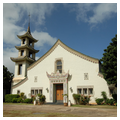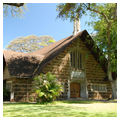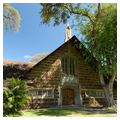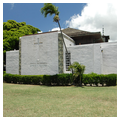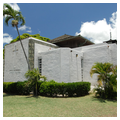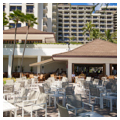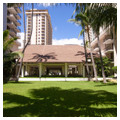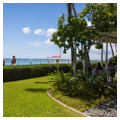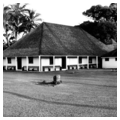The 1920s and 1930s were a time when consideration of Hawaii's strong sense of place—its environment, local materials, and multicultural traditions—coalesced in a regional architectural movement. Hawaii-raised architect C. W. “Pop” Dickey helped develop this special architecture along with other members of Honolulu's design community who designed such buildings as Hart Wood's First Chinese Church of Christ and First Church of Christ Scientist, Bertram Goodhue and Associates' Honolulu Academy of Arts, Claude Stiehl's Church of the Crossroads, and Harry Sims Bent's Pineapple Research Institute.
In 1926, Dickey had returned home after a twenty-year hiatus in California. He reestablished his architectural partnership with Hart Wood and obtained as one of his first commissions three now demolished cottages on the grounds of the Halekulani Hotel. With the construction of these modest buildings, Dickey introduced to Hawaii a new, regionally appropriate architectural design. At the time, he noted in the Honolulu Advertiser of March 14, 1926, “I believe that I have achieved a distinctive Hawaiian type of architecture. The cottages seem to fit the landscape. They are simply designed, gathering character from the roof.” These simple, wood cottages featured screened lanai, lava-rock footings and columns, and double-pitched hipped roofs. The last, with their characteristic break at the eave line, provided protection from the sun and rain while allowing for convenient opening of casement windows. Dickey would use this form on many subsequent buildings, and it became known in the Islands as the “Dickey” or “Hawaiian-style” roof. He claimed the roof was inspired by Hawaiian thatched houses, but a more direct prototype may have been the Waioli Mission Hall on the island of Kauai, built by Dickey's grandfather William P. Alexander and restored by Dickey and Wood in 1921.
The style introduced by Dickey in the Halekulani cottages caught on quickly, as witnessed by the similar styling of the Niumalu Hotel demolished as early as 1927. Over the next ten to fifteen years, the form was used for libraries, government offices, commercial enterprises, and houses. Dickey utilized the picturesque roofline in a number of his buildings including the Wailuku Library, the Territorial Building in Wailuku, the Alexander and Baldwin Building, and U.S. Immigration Station. In addition, the building supply firm Lewers and Cooke helped popularize the form, with its building catalogue expounding the appropriateness of the roof for Hawaii's tropical climate. The high center hip allowed for ample air space to insulate the interior from the heat of the sun. Wide overhangs shielded the windows from the sun and rain while allowing them to open to the trade winds. In an article in the February 12, 1938, edition of the Honolulu Star Bulletin, Ray Morris, Lewers and Cooke's in-house architect, noted that “The small house . . . does not present many opportunities for architectural embellishment. The roof design is the only place where originality can be exercised without being obvious.” With their simplicity and openness, the Hawaiian-style houses of the 1920s and 1930s are gracious reminders of this earlier time's unpretentious lifestyle and hospitality.
Writing Credits
If SAH Archipedia has been useful to you, please consider supporting it.
SAH Archipedia tells the story of the United States through its buildings, landscapes, and cities. This freely available resource empowers the public with authoritative knowledge that deepens their understanding and appreciation of the built environment. But the Society of Architectural Historians, which created SAH Archipedia with University of Virginia Press, needs your support to maintain the high-caliber research, writing, photography, cartography, editing, design, and programming that make SAH Archipedia a trusted online resource available to all who value the history of place, heritage tourism, and learning.


